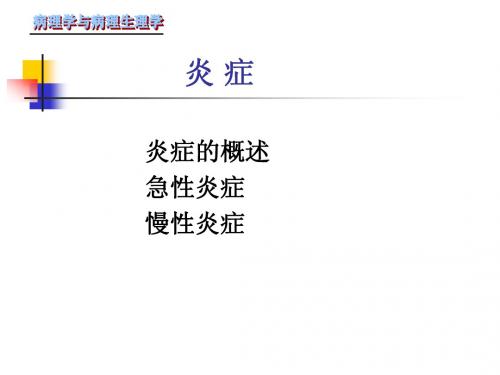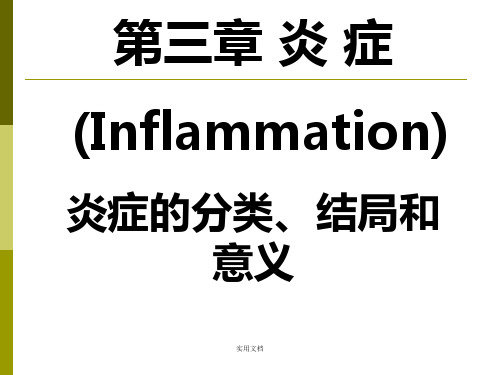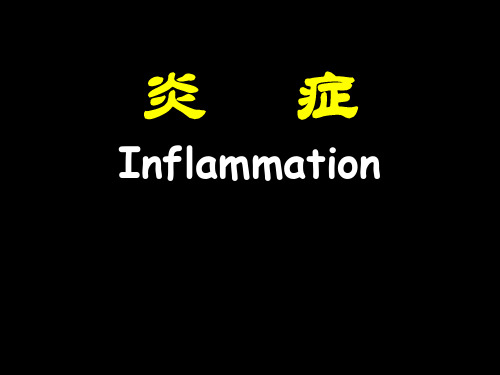炎症不同种类(英文)different inflammation types
炎症2的内容

1.浆液性炎症(serous inflammation) (1)特征:炎症局部以血清渗出为特征,渗出的主 要成分是浆液,混有少量白细胞和纤维素及变质的间皮 或上皮。 (2)病因:高温(皮肤水泡);强酸强碱;细菌毒素 ;病毒;蜂毒、蛇毒,免疫复合物。
(3)好发部位: 疏松结缔组织、粘膜、浆膜。 (4)结局:大多数病因去除后 ,渗出的浆液吸收,局部不留痕 迹;大量积液,影响器官功能。 如心包腔和胸膜腔积液。
2.纤维素炎症(fibrinous inflammation) 特征:渗出物中含有大量纤维蛋白。常混有中性粒 细胞及细胞碎片。 病因:白喉杆菌、痢疾杆菌、肺炎双球菌的毒素, 内外源性化学物质,如尿素、汞等。 血管壁损伤重。
好发部位:粘膜、浆膜、肺。 类型:据发生部位分为: (1)发生在粘膜者:渗出的纤维素、白细胞和坏死组 织等混合在一起,形成一层灰白色膜状物,称为假膜 。故发生于粘膜的纤维素性炎症又称假膜性炎症。
疖:(fu见于颈项部。 痈:(carbuncle) 指皮肤多个疖的融合。需切开引流。
(2)蜂窝织炎(phlegmonous inflammation)
病变特征: 大量中性白细胞弥漫地 浸润组织间隙,使组织呈蜂 窝状。
病因: 溶血性链球菌,可分泌透明质酸酶和链激酶,使炎症 得以弥漫扩散。 好发部位: 皮肤、肌肉、阑尾。 结局: 单纯性蜂窝织炎痊愈后一般不留痕迹;严重者病变进 展快,范围广,局部淋巴结肿大,压痛,伴有明显的全 身中毒症状。
(3)表面化脓和积脓 (superficial purulence) 粘膜或浆膜的化脓性炎症。 大量中性白细胞主要向表面渗, 深部组织没有明显的炎细胞浸 润。 如化脓性尿道炎、化脓性支气 管炎。 浆膜、胆囊、输卵管积脓 (empyema)。
炎症的类型及病变特点

形成含有脓液的空腔; 同时,肉芽组织增生,
在坏死组织周围形成脓肿膜,脓肿便告形成。
(2)蜂窝织炎(phlegmonous inflammation)
为发生在疏松组织的弥漫性化脓性炎。常见 于皮下组织、粘膜下、肌肉等。
蜂窝织炎主要由溶血性链球菌引起,链球菌能 分泌透明质酸酶和链激酶,透明质酸酶能降解结 缔组织基质中的透明质酸;链激酶能溶解纤维素, 故炎症不易被局限,细菌容易通过组织间隙和淋 巴管扩散。表现为炎区组织间隙有明显水肿和大 量中性粒细胞弥漫浸润。
当机体抵抗力减弱、病原作用增强或再感染时,可在慢 性炎症的基础上转化为急性炎症,即慢性炎症急性发作。
急性炎症与慢性炎症
急性炎症 急短 变质 渗出 edema N
慢性炎症 缓长 增生 ML
二、炎症的病理分类
任何炎症中都有变质、渗出、增生等改变,但由于 致炎因子不同、组织特性的不同,每一种炎症往往以 变质、渗出、增生中的某一种改变为主,据此将炎症 分为变质性炎症、渗出性炎症和增生性炎症三大类型。
41
5、卡他性炎(catarrh inflammation)
是发生于粘膜组织的一种轻度渗出性炎症。其特点是除 渗出液外,粘膜上皮细胞及其腺体分泌明显增强。
因此,粘膜表面常见混合有大量粘液的渗出液顺着粘膜 向下流,希腊语将顺势下流称为“catarrh”,故称卡他性 炎。 根据渗出物性质不同,卡他性炎可分为: (1)浆液性 (2)粘液性 (3)脓性卡他性炎。
(二)渗出性炎症 (exudative inflammation)
炎症局部以渗出病变为主并有大量的渗出物形成, 组织和细胞的变性、坏死次之,细胞的增生较轻的一 类炎症,多为急性炎症。 根据渗出物主要成分不同分为: 1、浆液性炎症 2、纤维素性炎症 3、化脓性炎症 4、出血性炎症,等类型。
炎症的类型.

二、渗出性炎
二、渗出性炎
2.病因: 葡萄球菌(疖、痈);链球菌(化脓性阑尾炎);脑膜炎 双球菌(化脓性脑膜炎);大肠杆菌、绿脓杆菌。 3.分类:根据病变不同分为三种: 脓肿 蜂窝织炎 表面化脓和积脓
二、渗出性炎
(1)脓肿(abscess) 概念:为局限性化脓性炎症,主要特征为组织坏死溶解,形 成充满脓液的腔。 肉眼:脓液粘稠(黄色、浆糊样) 好发部位:皮肤(疖和痈)和内脏。 病原菌:金黄色葡萄球菌。 结局: 小脓肿——吸收消失。 大深部脓肿——切开排脓引流,疤痕形成。 深部脓肿向体表或自然管道穿破 病理性盲管 (窦道、瘘管)
二、渗出性炎
二、渗出性炎
(3)表面化脓和积脓(surface suppuration and empyema)
表面化脓 ——发生于浆膜或粘膜组织的表浅的化脓性炎症。中 性粒细胞主要向表面渗出,深部组织没有明显炎性细胞浸润。
积脓 ——脓液蓄积在浆膜腔、心包、胆囊、输卵管等腔内。
二、渗出性炎
二、渗出性炎
假 膜 性 炎
喉 结肠
二、渗出性炎
假 膜 性 炎
二、渗出性炎
二、渗出性炎
二、渗出性炎
二、渗出性炎
大叶性肺炎
二、渗出性炎
5. 结局:
(1)溶解吸收。 (2)粘膜表面的假膜脱落。 (3)浆膜机化、粘连(纤维渗出过多,不能完全吸收):浆膜腔 闭塞、大叶性肺炎肉质样变。
心包腔闭锁
二、渗出性炎
疏松结缔组织:蚊虫叮咬——炎性水肿
二、渗出性炎
粘膜:喉头水肿
二、渗出性炎
浆膜:结核性胸膜炎——胸腔积液出性炎
(二)纤维素性炎
1.病变特征:以纤维蛋白原渗出为主要病变。 2.病因: 细菌毒素(白喉、痢疾、肺炎球菌) 内、外源性毒素(尿素、汞中毒) 3.病变特点(光镜下): 大量片状质地均匀红染的纤维素交织呈网状,间隙中有中性 粒细胞及坏死细胞的碎屑。
炎症

发生在肺的纤维素性炎 症,因肺泡腔内大量纤 维素渗出而造成肺实变。
3. 化脓性炎 特 点:以中性粒细胞渗出为主,伴不同程度组 织液化坏死和脓液形成。 部 位:皮肤、粘膜、浆膜、脑膜及各实质器官。
类型: 1) 表面化脓和积脓: 指发生于粘膜、浆膜表面的化脓性炎症; 当化脓性炎发生在浆膜、胆囊或输卵管时,脓液可 积聚在浆膜腔、胆囊或输卵管内称积脓。
内源性:补体成份 白细胞三烯B4 细胞因子
趋化因子
外源性:可溶性细菌产物
白细胞的游出和趋化作用
④白细胞在局部的作用: 1)吞噬作用
指白细胞对病原体和组织崩解碎片进行 吞噬和消化的过程。为炎症防御反应的 最重要过程。
中性粒细胞(小吞噬细胞) ①吞噬细胞种类 巨噬细胞(大吞噬细胞) ②吞噬过程 识别及附着 吞入 杀伤和降解
致敏淋巴细胞 产生淋巴因子(细胞免疫) 浆细胞产生抗体(体液免疫)
3)组织损伤作用
白细胞释放产物 溶酶体酶 氧自由基 前列腺素 白三烯 组织损伤
炎细胞种类、功能及临床意义
类 别 功 能 临床意义 见于急性炎症,特别 是化脓性炎症时,变 性坏死后成为脓细胞。 中性粒细胞 运动活跃,吞噬力强, 能吞噬细菌 、组织碎 片、抗原抗体复合物, 崩解后释放蛋白溶解 酶,能溶解细胞碎片、 纤维蛋白等。 运动及吞噬力很强,能 吞噬中性粒细胞不易吞 噬的非化脓菌、较大组 织碎片、异物,可演变 为类上皮细胞、多核巨 细胞等;能将抗原信息 传递给免疫活性细胞, 发挥免疫效应。
炎症
炎症的概述 急性炎症 慢性炎症
第一节
炎症的概念
炎症的概述
炎症(inflammation)是指具有血管系统的活体 组织对致炎因子所发生的防御为主的反应。中心 环 节是血管反应。 致炎因子 → 活体组织 → 血管反应
炎症的类型、结局、意义

实用文档
肉芽肿类型 感染性肉芽肿: 结核结节 异物性肉芽肿
形成肉芽肿的条件 (1)病原体或异物不能被消化,刺激长期
存在。 (2)细胞介导的免疫反应。
实用文档
实用文档
结核结节 干酪样坏死 类上皮细胞:Epithelioid cell 多核巨细胞:郎罕氏巨细胞 Langhans 淋巴细胞 纤维母细胞
浆液性卡他 粘液性卡他 脓性卡他
实用文档
慢性炎症
概念:持续几周、几个月。 急性→慢性 潜隐发病→慢性 以淋巴细胞、浆细胞、组织细胞浸润为主,伴 不同程度的纤维组织增生和实质细胞的增生。
实用文档
1.一般增生性炎症 特点: 呈一般慢性炎症的基本病理变化 a.炎细胞:巨、淋、浆 b.纤维母细胞增生,小血管增生,
实用文档
实用文档
放线菌病 实用文档
组织胞浆菌病
实用文档
着色性芽实用生文档 菌病
马内菲青霉实用文菌档 病
慢性肉芽肿性炎
归类概念
特殊的慢性炎症 以浸润的单核细胞与增生的组织
细胞(巨噬细胞)为主形成的境 界清楚的结节状病灶。
实用文档
3. 炎性息肉
(inflammatory polyp) 粘膜上皮和腺体及肉芽 组织增生形成的突出于 粘膜表面的增生性突起
(一)细胞释放的炎症介质
1.血管活性胺: 组织胺、5-羟色胺(5HT) 2. 前列腺素(PG)、白细胞三烯(LT) 3.白细胞产物:氧自由基, NO,溶酶体酶 4.细胞因子(cytokine): 淋巴因子,白细胞
介素2(IL-1),肿瘤坏死因子(TNF)
实用文档
(二) 血浆中产生的炎症介质
炎症分类,结局、意义(讲义)

炎症介质(inflammatory mediator)
概念:介导和参与炎症反应具有生物活 性的的化学物质
功能: 血管扩张 血管通透性增高 趋化作用 发热、疼痛
炎症介质
内源性
细胞源性: 白细胞产物,NO,溶酶体酶 血浆源性: 凝血系统产物
外源性: 细菌及其代谢产物
Inflammatory Mediators
3.肉芽肿形成条件和组成 分类
感染性肉芽肿: 结核结节 异物性肉芽肿: 异物肉芽肿 形成条件 (1)病原体或异物不能被消化,刺激长期存在 (2)细胞介导的免疫反应
组成
上皮样细胞:Epithelioid cell 多核巨细胞:上皮样细胞融合而来
多核 胞浆内可见吞噬物
举例 结核结节
组成
结核结节 干酪样坏死 类上皮细胞:Epithelioid cell 多核巨细胞:郎罕氏巨细胞( Langhans) 淋巴细胞 纤维母细胞
部位: 粘膜: 假膜性炎(痢疾,白喉) 浆膜:纤维素性心包炎(绒毛心) 肺内:大叶性肺炎(肺实变)
白喉:假膜
绒毛心 (hairy heart)
大叶性肺炎
3.化脓性炎 ( Purulent Inflammation)
概念:以中性粒细胞大量渗出,并伴有不同程 度的组织坏死和脓液形成的炎症。
化脓(suppuration):大量渗出中性粒细胞伴 组织坏死、溶解液化的过程
11.慢性炎病灶中可以增生的细胞有()()()()()
A.中性粒细胞 B.淋巴细胞 C.血管内皮细胞 D.成纤维细胞 E.单核细胞
不利
渗出—压迫(重要器官) 纤维粘连
高热持续 希望
运用炎症的病理知识 ●制定合理治疗措施 ●增强患者的防御功能 ●及早消除致炎因子 ●减少组织的损伤 ●促进炎症早日愈复
炎症(Inflammation)-精品医学课件

免疫作用(Immunological Reaction)
• T细胞:细胞免疫 • B细胞:体液免疫 • NK细胞
白细胞在局部的作用
吞噬作用(Phagocytosis & Degranulation) 免疫作用(Immunological Reaction) 组织损伤作用(Leukocyte-Induced
幽门螺杆菌
淋球菌
人类免疫缺陷病毒 (HIV-1)
阿米巴滋养体
一切外源或内源性因素造成的 组织损害。
能否引起炎症还与机体本身有 着密切关系。
炎症的类型
• 超急性炎症 (peracute inflammation)
• 急性炎症 (acute inflammation)
• 慢性炎症 (chronic inflammation)
• 液体渗出
• 白细胞渗出及作用
渗出液(exudation) • 炎性水肿(inflammatory edema) • 炎性积液(inflammatory hydrops)
渗出液(exudation) • 炎性水肿(inflammatory edema) • 炎性积液(inflammatory hydrops)
白细胞的识别作用
• 识别微生物产物的受体:白细胞TLRs受体 • G蛋白偶联受体:识别细菌短肽 • 调理素受体:识别Fc片段、补体C3b、凝集素 • 细胞因子受体:识别干扰素
白细胞的激活
激活磷脂酶C 4.5二磷酸磷脂酰肌醇
水解 三磷酸肌醇+二乙酰基甘油
趋化因子-受体 降解细胞膜磷脂 激活G蛋白
• 稀释毒素,减轻损伤 • 提供白细胞的微环境 • 含抗体、补体、溶菌素 • 纤维素限制扩散,有利吞噬,修复作用 • 带抗原至淋巴结——免疫反应 • 压迫,阻塞 • 粘连 • 积液
炎症的类型

炎症的类型一、炎症的一般分类原则:概括的分为变质性炎、渗出性炎和增生性炎。
二、变质性炎:以变质变化为主的炎症,渗出和增生改变较轻微,多见于急性炎症。
1、部位:肝、肾、心和脑等实质性器官。
2、疾病举例:急性重型肝炎,流行性乙型脑炎。
三、渗出性炎:以浆液、纤维蛋白原和嗜中性粒细胞渗出为主的炎症,多为急性炎症。
(一)浆液性炎:以浆液渗出为其特征。
1、部位:发生于粘膜--浆液性卡他性炎;浆膜--体腔积液;疏松结缔组织--局部炎性水肿2、对机体的影响(二)纤维素性炎:以纤维蛋白原渗出为主,继而形成纤维素。
HE切片中纤维素呈红染交织的网状、条状或颗粒状。
1、部位:发生于粘膜--假膜性炎;浆膜--如"绒毛心";肺组织--见于大叶性肺炎2、对机体的影响(三)化脓性炎:以嗜中性粒细胞渗出为主,并有不同程度的组织坏死和脓液形成为特点。
1、表面化脓和积脓(empyema)2、蜂窝织炎(phlegmonous inflammation):指疏松结缔组织的弥漫性化脓性炎,常发生于皮肤、肌肉和阑尾。
主由溶血性链球菌引起。
3、脓肿(abscess):指局限性化脓性炎,可发生于皮下和内脏。
主由金黄色葡萄球菌引起。
4、出血性炎(hemorrhagic inflammation)上述各型炎症可单独发生,亦可合并存在。
四、增生性炎(一)非特异性增生性炎(二)肉芽肿性炎(granulomatous inflammation):以肉芽肿形成为其特点,多为特殊类型的慢性炎症。
1、肉芽肿的定义:由巨噬细胞及其演化的细胞,呈限局性浸润和增生所形成的境界清楚的结节状病灶。
2、常见病因3、肉芽肿的形成条件和组成(1)异物性肉芽肿(2)感染性肉芽肿4、肉芽肿性炎病理变化:以结核结节为例:中央--干酪样坏死;周围--放射状排列的上皮细胞;可见郎罕氏巨细胞;外围--淋巴细胞、纤维结缔组织。
- 1、下载文档前请自行甄别文档内容的完整性,平台不提供额外的编辑、内容补充、找答案等附加服务。
- 2、"仅部分预览"的文档,不可在线预览部分如存在完整性等问题,可反馈申请退款(可完整预览的文档不适用该条件!)。
- 3、如文档侵犯您的权益,请联系客服反馈,我们会尽快为您处理(人工客服工作时间:9:00-18:30)。
Histological types
1 Alterative inflammation
(1) Alterative changes are the most obvious, exudative and proliferative changes are slighter.
(2) Commonly seen in parenchyma organs
(3) Causes: Virus, toxin, chemical poison, etc.
(4) e.g: fulminant hepatitis, type B epidemic encephalitis, poliomyelitis, caseous pneumonia, etc.
2 Exudative inflammation
Excess of a particular component of the inflammatory exudates imparts distinctive features.
(1) Serous inflammation
①Watery, low protein content, derived from blood or serosal lining cells.
②Commonly seen in:
Mucous membrane, serosa, lung, loose connective tissue, skin.
③Examples: Blister formation following burning, the pleural effusion associated with tuberculosis, common cold, etc.
(2) Fibrinous inflammation
①Much fibrin due to coagulation of large fibrinogen outpouring.
②Causes: Shigella
Streptococcus peneumoniae
Corynebacterium diphtheriae
Hg poison
Uremia
③Commonly seen in
a. Serosa
b. Mucous membrane: Pseudo-membrane
c. Lung
④Examples: Rheumatic, pericarditis, dysentery, diphtheriae, lobular peneumonir, etc.
(3) Suppurative inflammation
①Definition: Much exudate with lots of neutrophils and liquefied nerotic tissue (pus) occurs. Pus composed of: dead and dying neutrophils, liquefied tissue, pyogenic organisms.
②Causes: staphylolcocci, pneumococci, gonococci, gram-negative rods, and some nonhemolytic streptococci.
③Types:
a. Abscess: a localised collection of pus in an organ or tissue.
Abscess could formation:
Ulcer: localized defect in an epithelial surface due to necrosis.
Sinus: an abnormal tract leading from a cavity to the surface.
Fistula: a tract open at both ends, through which abnormal communicaton between two surface is established.
b. Phlegmonous inflammation
Definition: wide-spread purulent inflammation in loose tissue, and appendix
Causes: hemolytic streptococci
c. Surface purulent inflammation and Empyema
Surface purulent inflammation: purulent inflammation of mucosal or serosa surface. Empyema: a collection of pus in a hollow viscus, e. g. in the gall-bladder or appendix.
(4) Haemorrhagic inflammation:
Inflammation associated with conspicuous haemorrhage as a result of vascular damage, e. g. meningococcaemia.
(5) Catarrhal inflammation:
Inflammation of mucosal surfaces with hypersecretion of mucus, e.g. common cold
3 Proliferative inflammation
(1) General proliferative inflammation
Proliferative constitutions:
Fibroblasts, endothelium, macrophage, and sometimes coated-epithelium, adenocytes, parenchymal cells, etc. commonly seen in chronic inflammation
(2) Special types
①Inflammatory granuloma (granulomatous inflammation)
Definition: Nodular area of histocytes (macrophages)
Proliferation that has been transformed into epithelioid cells, surrounded by a collar of lymphocytes, occasionally fibroblasts and plasma cells.
(3)Types:
①Infective granuloma:tuberculosis, syphilis, sarcoidosis, cat-scratch fever, leprosy, brucellosis, some of the mycotic infections, etc.
Example: granuloma of tuberculosis focal aggregation of monocyter that have undergone alteration to epithelioid cells. Or Caseous necrosis is in the center. The enclosing wall contains several large mutinucleate giant cells, the Langhans type, with peripheral orientation of the nuclel, and many lymphcytes and fibroblasts.
②Foreign body’s granuloma
Features: foreign bodies
Foreign dody giant cell: seen in association with particulate insoluble material. Nuclei scattered throughout cytoplasm. No caseous necrosis
③Inflammatory polyp
④Inflammatory pseudo-tumor。
